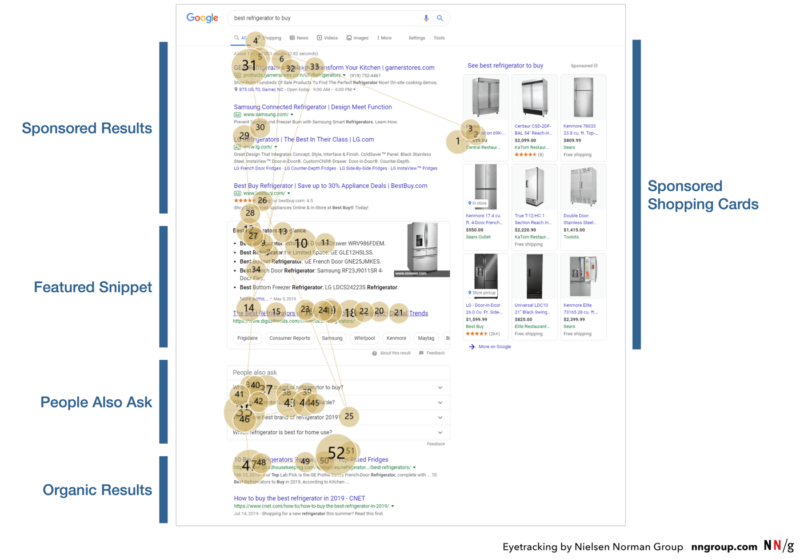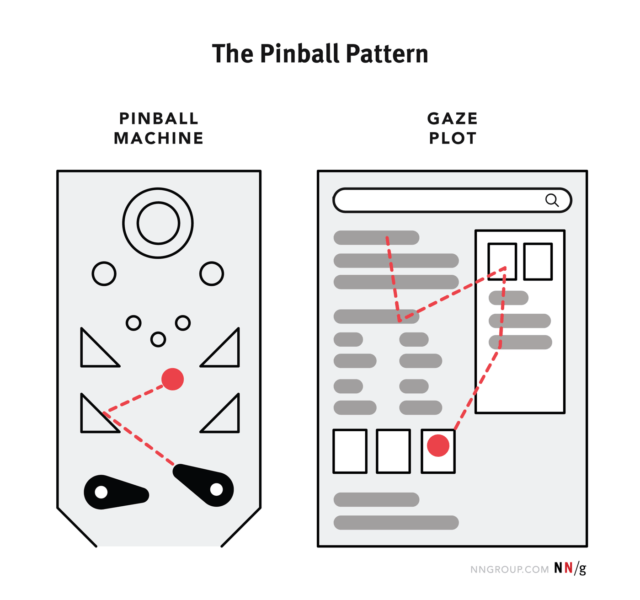We know the number of features like knowledge panels, images, local packs and other elements have proliferated in search results in recent years, and that has had a significant impact on SEO strategies. Now, a new study aims to show how much the introduction and variation of these features are changing searchers’ behavior.
When search engine results page (SERP) features, such as a sponsored product carousel, video carousel, featured snippet, or other rich results, were present on a search results page, they were looked at by the user in 74% of cases, according to the study by the Nielsen Norman Group. The visual weight of SERP features influences the path of the user’s gaze and, since the number of features can vary from query to query, the gaze pattern is nonlinear, the study also found.
The findings were derived from an analysis of 471 queries made by participants in eye-tracking and usability-testing studies conducted between 2017 and 2019.
How SERP features influence user behavior and actions. When search results features such as featured snippets were present on the results page, they were looked at by the user in 74% of cases, the study found.
“Images definitely drew attention — they are visually attractive and also helped users quickly check that the results were about the topic they were looking for,” Kate Moran, author of the analysis and senior user experience specialist for the Nielsen Norman Group told Search Engine Land. “But elements that gave quick answers also received a lot of attention — featured snippets, knowledge panels, and People also asked.”
Interestingly, this seeming added complexity and variation in search results pages don’t appear to be keeping users from taking action relatively quickly. Participants took an average of just 5.7 seconds to click their first selection.
A separate analysis by Yext found that consumer actions on local business listings — driving directions clicks, clicks to call businesses — in search increased by a larger margin (17%) than impressions of business listings (10%) last year. “[This suggests that] customers are finding what they want faster,” the Yext analysis concluded. “Whether searchers are learning to use more specific queries or search engines are getting better at understanding those queries, customers are spending less time searching and more time engaging with businesses.”
The pinball pattern. The value of the top spot in a search results page is predicated on the idea that users browse listings sequentially. Since the modern results page can include different types of results, ads and interactive elements, in addition to traditional organic listings, users are directing their gaze to these various elements in a nonlinear fashion. The Nielsen Norman Group has dubbed this phenomenon the “pinball pattern.”
“Because search-results pages are now so inconsistent from query to query, users are often forced to assess the page before digging in and making a selection,” according to the report.
Any given query can surface numerous search features, ranging from rich answers to carousels and everything in between. This assortment of information plays a critical part in shifting the user’s attention across the page. “That means that layout of a SERP can determine which links get visibility and clicks.” Additionally, the position of visually compelling elements may also impact the visibility of nearby organic results, the report suggested.

What results get seen and clicked. One striking difference in the search behaviors of 2006 versus today is in clicks on the first result on the page. In 2019, the first result (defined as the first item appearing under the search box, which means it could be an ad) received 28% of clicks. That compares to 51% of clicks that went to the first result in 2006.
While the study acknowledges the increase in zero-click searches, there is more opportunity for exposure and clicks for ads and listings a bit further down the page than in the past. That said, ads and features like instant answers are much more prevalent in the top spot today than in 2006, so that should be kept in mind when interpreting this data.

The study found that the first three positions received more than half (59%) of clicks, with lower positions receiving a slightly higher proportion of clicks than in 2006.
Instances in which users continued to browse the results page as they waited for a clicked result to load were also observed. Some users returned to the search results to select another listing they had been eyeing earlier if their first selection did not resolve their search.
Below the fold value varies. Only 5% of selections in navigational and fact-finding queries occurred below the fold (the assortment of listings that appeared after the user scrolls to see more results). For more complex research tasks, 20% of selections were below the fold.

This suggests that companies publishing in-depth content may still be able to attract clicks even if they’re further down on the SERP.
However, users only ventured past the first results page for 2% of queries.
Why we should care. If this study provides an accurate reflection of how the general public navigates search results, there is a clear incentive for organizations to optimize for search features. The top organic spot is just one of many factors that can add to your visibility on the search results.
Traditional “blue link” organic listings have ceded prime SERP real estate to ads and rich answers, which have more than doubled in mobile results since last year, according to a study by Perficient Digital. Consumer actions in Google My Business listings, another type of rich result, are getting more clicks than last year as well. The trend towards more search features has greatly affected user behavior — the majority of Google searches now end without a click to other content, meaning there’s less organic traffic available to publishers. These search elements are getting shown more, not less.
Marketers should be formulating their strategies with these trends in mind. By optimizing for the features that make the most sense for your organization, a technique that SparkToro’s Rand Fishkin referred to as “on-SERP SEO” in his SMX keynote last week, brands can still find ways to reach their audiences through the search results.

